

|
Mexico City was beautiful! We didn't realize until later that we'd hit a particularly good day when winds had blown away the smog. We got off the airplane, bought a taxi ticket to Zone 4 for 15,000 pesos, and had a wild ride through heavy and fast moving traffic to the "Zona Rosa" where the Casa Gonzalez is located. It took our driver a while to find the address and, by the time he did, it was pouring rain. Casa Gonzalez is a big, old house which has been converted to a small hotel located just around the corner from the U.S. embassy. The taxi dropped us on the sidewalk outside the high walled building and by the time we found the bell and got the attention of the maid we were both soaked. She showed us to a small room on the second floor which, although small, was clean with a view onto a flower-filled patio. We changed clothes and, since the rain soon stopped, went out for a walk. We wandered around the Zona Rosa for an hour or so, gawking at the skyscrapers, parks, and sculptures, before returning to Casa Gonzalez for dinner. There we met a very nice gentleman named Jorge E. Ortiz Gonzalez who, with his wife, has run the place for forty or more years. He dined with us and four others, a family of three from the embassy and another interesting lady who had been staying there for more than a month. We had a super-good meal, including a drink, for which he charged the whole sum of $3.50 per person.
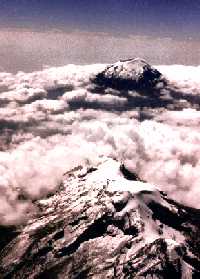
|
Right out of Mexico City is the snow capped volcano Popocatepetl, a 17,887 foot high mountain with a sister only a few feet lower. They were bright and shining in the morning sun. Guatemala City is almost completely ringed by volcanos, not as high but some still actively venting. We landed about 9:30, whizzed though customs, and went directly to the car rental agencies. After checking with several we decided on Tally where a pretty little lady named Patricia rented us a Mitzibushi Mini-van at a little under $40/day, unlimited mileage. I can fit into the vans better than the Toyotas and Nissan compacts and the van was only about $3.00/day more. |
The hooker came when they went to get the car and found it had a mechanical problem. No problema! Mario, a driver, loaded us and our bags into his own van and drove us to the downtown office, stopping on the way at Credito Matica to let me get a cash draw of 2,750 Qetzales ($500.00). There they wrote out a new contract and fixed us up with a brand new 1990 van. Getting out of the city was a bit exciting...it would have been much easier from the airport...but I managed to work our way through the maze of cars and buses to the highway leading west to Antigua without bashing into anything or getting bashed. Once on the highway it was still quite a trick staying on the right route... for the newcomer the road signs leave much to be desired. We only took a couple of wrong turns before getting out of town and rolling down the right highway. The road is really pretty good, four lane all the way to Antigua with only an occasional pot hole. We arrived about noon and, after another back street detour because of a closed road, found our way to the village square where dozens of "guides" volunteered to provide their services for a small fee. We decided to gamble on our own, rather than on an unknown guide; and, after having a steak sandwich lunch for which we paid $1.25, we set off in seach of a hotel. We ended up at the Antigua Ramada, nice but very like the Ramadas anywhere. It was a good place from which to start our exploring.
We spent the afternoon wandering around Antigua. As the name implies, it is a very old town with lots of ruins scattered around, some dating from the 1500's. The streets are narrow and paved with cobblestones but quite well maintained. It's a little hard to keep track of where you are because all of the houses, mostly built of adobe blocks and stuccoed, are joined in a solid wall along the street and even in the business area there are few signs visible without stnding directly in front of a store...you can't tell one street from another. It took us a while to figure out that if we started from the central plaza and kept the big volcano in sight we could keep our bearings. We had planned on going out to dinner but on the way stumbled into a very nice German restaurant in the hotel and ate there. I failed to get the name of the place and can't find it in our books but it was excellent!
By the time we'd spent an hour and a half in the market we were both pooped, I think we were feeling the altitude. Antigua is at 5000 feet, Guatemala City over 6000. We have been living at sea level for a long time. Anyway, we decided to drive on to the highly recommended Lake Atitlan. The first five miles or so of the road was narrow and rough, winding up through a deep canyon. We went through a number of small villages, each with its central pool where women were washing their clothes. These are interesting ...around a large concrete basin are built individual tubs for use in washing. One we saw must have been thirty feet across with fifty or more tubs around the perimeter. It was covered with a palapa roof and dozens of ladies were washing clothes around the edge. We stopped for a few minutes at Lago Luna, a beautiful little resort lake which was filled with picnicing locals from the nearby city of Chimaltenango. As soon as we got back on the main highway at Chimaltenango both the road and the scenery changed. The road was as good as any secondary highway in the States and it led across the tops of ridges with spectacular views of distant, and not so distant, volcano cones.
We are learning to keep very close track of road signs so, without any more wrong turns, we managed to find our way to Panajachel (Pronounced Pana-hah'-chel), the major town on Lago Atitlan. We caught our first glimpse of the lake from many miles away, it is a huge cauldera, 25 kilometers long and ten across, blown out of a monster volcano millions of years ago. Looking south from the highway there are three major cones and several small ones along its south shore. As we decended from over 7,000 ft to lake level at about 5,000 we went through the city of Solola, built on the mountain side with a super view of the lake and volcanos below. It took us a while to navigate the narrow street that led almost directly through its busy market. The farther we went the more colorful the dress of the native people became. Here in Solola it appears that all of the Indian people wear the native dress. The ladies wear the huipils and a skirt called a corte with a sash called a faja. The men wear brightly colored shirts of handwoven fabric and multi-colored pants, also of hand made fabric. All seem to carry some kind of load on their head or back, some huge baskets which look very heavy. From Solola the road gets very steep as it winds down the mountain to the lake below. Just before reaching Panajachel we passed a spectacular waterfall cascading from several hundred feet above the road to fall into a pool where women were washing clothes.
In Panajachel we checked into the Cacique Inn and crashed, getting up only to get a bite of dinner in the dining room. We are both feeling poorly...still not sure whether it's the altitude or a bug of some kind.
| The skipper, a young man of about thirty, did everything himself, casting off the lines, driving the boat, and tying up at the end of our voyage. We landed at a dock below the village where forty or fifty native women were washing clothes on the rocks along the shore, waist deep in the water of the lake. Here we got our first view of a truly Indian village as we walked up the hill to the market place. | 
|
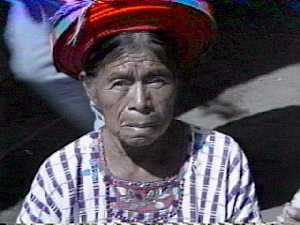
|
Although obviously influenced by the tourist dollar, the goods sold in the shops along the streets and in the market are the same as you see the natives wearing and the busy trade in everything from chickens to alvacados isn't just for show. Everyone seemed very friendly, although the old woman spinning wool and the young girl weaving multicolored shashes wanted to be paid something for having their pictures taken. |
We bought a shirt for me and some material which Diane had requested. The schedule gave us about an hour and a half before 11:30 when the skipper cast off the lines after tooting several warning blasts on his whistle amid the hawking of huipils, shawls, and masks by the ladies on the dock. Even then he had to go back to pick up one German couple who couldn't quite make it back on time.
Back in town we crashed again, sleeping away most of the afternoon.
Our room is very comfortable with sliding doors of glass and ornamental iron work, a fireplace which we haven't needed, a good sized double bed and a single bed, both with beautiful wool blankets as spreads. There's a big shower and modern plumbing with the hot and cold water valves reversed as is common down here. By the time we woke and felt ready to face the world again clouds were gathering over Panajachel. We drove though town, down the long, shop lined lane to the beach, past the plush Hotel del Lago, then out a rough trail to a "Playa Publica" where we had a cerveza at a palapa restaurant. On the way back we stopped and took some videos of a couple of guys loading pigs, first into net covered baskets three at a time, and then into the back of a pickup. You never heard such squealing! Just about then the rain started. Wow! It came down like it did in Panama. We went searching for a place to eat dinner, first to a nice looking joint which turned out to have a menu printed solely in English with entries to match. That wasn't what we were looking for, so next to a place highly recommended by the guide book which turned out not to open until 7:00 PM. We finally took a chance and managed to get the gold ring at a place called La Laguna where a friendly young lady helped us choose some excellent "tipical" food for a very reasonable price.
| Super day today! Not only were we feeling better, but we also stumbled into some neat things that made the day very special. We checked out of the hotel early, after drinking a couple of cups of the Cacique restaurant's excellent coffee, and headed up the mountain toward Chichicastenango where we hoped to catch the Sunday market. We stopped at the waterfall to take pictures and, while we were busy shooting the spectacular falls, a nice looking young lady in a Toyota also stopped, said, "Hi!",took a couple of pictures, then drove off. A few turns up the road we found her stopped again, taking pictures of the lake and volcanos. We also stopped, exchanged a few pleasantries, then she drove off again. About a quarter of a mile farther along we found her stopped again, this time in the middle of the road (A bad place to stop with all the bus traffic on the road). | 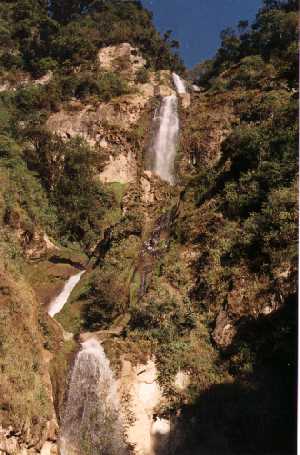
|
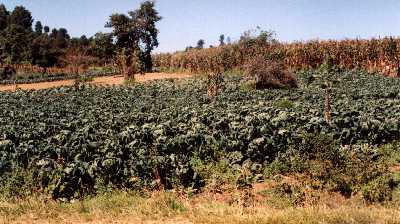
|
Here I have to explain that almost all of the cultivated land we have seen is planted in corn, and all of it at this time of year is about twelve feet high. Little plots of ground are planted with other crops, cabbages and carrots, beans and beets, brocoli and cauliflower, but they are always surrounded by a wall of tall corn. |
| As we stopped our benefactor introduced herself as Vivian Harvey. She's from Columbus, Ohio and has contracted with some of the local ladies to embroider "T"shirts which she sells in the states. Off though the cornfield she led us, stopping on the way to say "Buenos Dias!" to a young girl and a man carrying a musical instrument, all dressed in colorful native costume. Onward down a narrow dirt path we went, making a couple of 90 degree turns and ending up at an adobe building, or actually three buildings joined by adobe walls. | 
|
"Isabel, Isabel!", she called, and after a moment a nice looking native lady in a beautifully embroidered blouse appeared. She greeted us warmly as Vivian's amigos, and introduced her three sons, ranging in age from about five to thirteen.
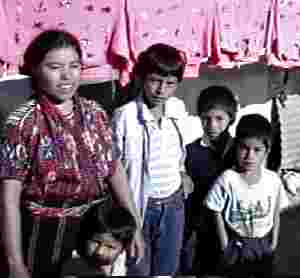
|
Vivian explaned that Lorenzo, the oldest, does all of the design for the embroidered figures, first drawing the design, then carving it on a wooden block which he then inks and stamps on the material to be embroidered. When I asked if we could take pictures Isabel said, "Si!" but then disappeared. Vivian explained that she had to change to better clothes to have her picture taken. A few minutes later she reappeared, now dressed in something fit for a museum. |
Back on the road, Vivian said she was hurrying to catch morning mass at the church in Chichicastanango, said she'd find us in the market, and took off down the road like the dogs were on her trail. We followed and soon caught up with her as thick clouds swept down on the mountain, cutting visibilty in thick fog and slowing her down. I stuck pretty close, not trusting myself to find our way in the fog. We got to the main highway, then off again on a side road to Chichicastenango where Vivian stopped and picked up three native hitchhikers. I was glad to be following someone who knew the way as we dove off the side of a cliff and down into a narrow ravine following switchbacks so tight that Vivian once had to back and try again.
| As we climbed out of the ravine and then down again toward the town, the fog cleared and we could see the town built on a ridge high above the surrounding valleys. As we neared the center of the town a dozen boys came running after our cars, waving and gesturing. They wanted us to hire them as guides to the city, but Vivian had her own boys already at the car, Victor, her regular, and Sebastian, who it turned out would be our guide. They stuck with us like glue for the rest of the day. We first went to the church where native men in the common dress swung tin cans of burning incense and others chanted in front of a small fire. We later learned that the incense is called estoraque and the fire on the quemador (alter) was burning pom (copal). | 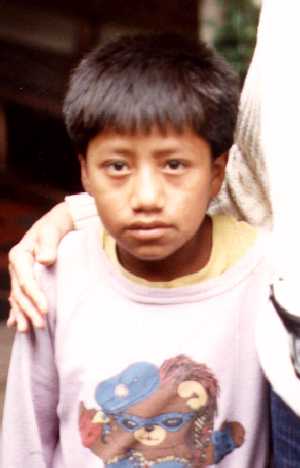
|
Inside the priest was delivering his sermon to a hundred or more people in a huge cathedral filled with smoke from the fires outside. Also in the chamber were four litters decorated with feathers of the kind described as used by both the Aztecs and Mayans at the time of the conquest. I was sorry not to be able to photograph these spectacular carriages. The next stop was the market where I almost had to crawl on hands and knees to get under the canvas and plastic roofs. (I find that the average Guatemalan Indian comes about to my waist.) But Vivian wanted a cup of coffee, and I could use some breakfast, so we found our way to where a lady and a couple of young girls were dishing out both. I ordered beans and rice to go with the coffee which was, of course, already sweetened with sugar as it was brewed in the pot. The beans and rice were good but Lois stuck to the coffee.
We broke up at that point, Sebastian leading us to the places where we could get the things we wanted for the "best" price, and Victor taking off with Vivian. We agreed to meet at a certain restaurant at noon. Sebastian turned out to be a pretty good shopper...the couple of times I rebelled and failed to follow his advice I'm sure cost me money. We loaded up with shirts, jackets, bags of all sizes, a blouse or two, and God knows what else before the noon whistle blew. We had a nice, but not outstanding lunch, and then set off again, this time for "La Montana", a hilltop shrine overlooking the city. It's a steep, switchback trail climbing somewhere between 500 and 1000 feet to a pine covered ridge. That's something I don't think I've mentioned before...this country is covered with pine and cedar, trees we sea level people don't associate with Latin America. Anyway, after much huffing and puffing, I made it to the top of the ridge where an Indian man, an old woman, and a young girl were performing some kind of ceremony in front of a stone alter. Lighted candles were set around the altar and marigold blossoms spread everywhere. The man chanted and swung his tin can of incense while the ancient crone watched. Sebastian and Victor said it was alright to take pictures if we paid a fee of two quetzales, the old lady asked for ten. We compromised on five.
The trip down was easier than the trip up. We stopped at a mask factory to look at some beautifully carved and painted masks. They were also making feathered headdresses for the upcoming Todos Santos and Dia de Muertos fiestas. We also stopped at a shop to which Victor led us which sold old things. Vivian bought a small stone carving and I a tiny figure in what might be jade.
At this point we separated again, Sebastian and I going to our van while Lois did some more shopping with Vivian and Victor. On the way to the car I bought Sabastian a pair of shoes, and item very much in demand in this country of walkers. We got back to the parking lot, paid a deaf boy, Antonio, for watching the car, and started to back out. Antonio then started banging on the side of the van and pointing to our front wheel...yep, flat tire. Fortunately, there was a tire repair shop right next door. A nice man, one of the very few Guatemalans we've seen with a pot belly, came to our rescue, changed the wheel to our spare, and promised the repaired tire in the morning.
| We headed off again for the Mayan Inn, a trip delayed a bit by huge trucks parked in every street we tried. We finally made it to find that our friend Vivian had left, headed back for Panajachel where she had a room in a small hotel. Sabastian helped us get our luggage, which by now is getting to be more than "carry-on", into the room, then we said goodby and were on our own again. Our room at the Mayan Inn was just off the central patio where two Scarlet Macaws and several other parrots played. It had high ceilings, a few nice paintings, some kind of a prayer apron hung above the fireplace, and no key for the door. Instead we were assigned a personal room monitor, Jorge, who was responsible for the "inventory" of our room. He was also our waiter at dinner. The room was a bit chilly so I lit the fire which was laid in the fireplace...using half of a candle for kindling which they hadn't provided. | 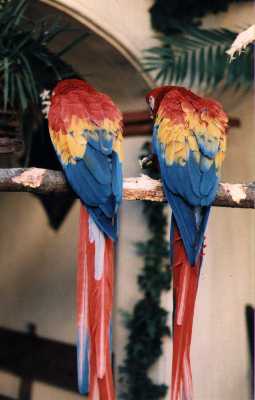
|
We got to Panajachel about noon and, after checking in again to the Cacique, had lunch in a place called the Casablanca where we ran into our friends Doug and Stella again. They were headed back to Guatemala City. We then spent the next couple of hours shopping on the long lane to the beach where hundreds of shops display thousands of local items.
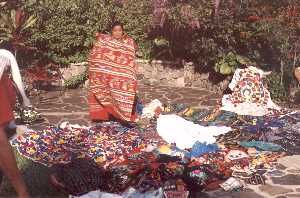
|
Interestingly, every market area seems to be a little different in their wares. Most have similar rugs and tapestries; but bags, shirts, sashes, and other smaller items differ widely. I guess the buyers don't range far from home. We didn't buy much more here...we are just about bought out. Not only are our Quetzales almost gone, we are reaching the limit on what we can carry. |
We went to dinner at La Laguna and who should come in just as we ordered...our buddy Vivian! She said she often ate there because of the good tipical food. We had a good dinner and a nice time getting better acquainted. In addition to her Guatemalan clothing sales, which is really a sideline for her, she is the promoter of a language school called the CEMANAHUAC EDUCATIONAL COMMUNITY. They teach Spanish to gringos all over the states. As I gather it, her job is setting up tours to Mexico and Guatemala designed to give students practical application of what they have learned. She's a very dynamic and outgoing lady, lots of fun to talk with. We dawdled over dinner and drinks until after nine, way past my normal bedtime.
We dropped our riders at Solola and then bucked the traffic coming down the hill to market all the way to the main highway. The morning was crystal clear and, once on top, we had spectacular views of the surrounding volcanos in the morning sunlight. Before leaving the Atitlan area we took a side trip as far as Godinez, a tiny village high on the mountain to the east of the lake. The ridge leading there has some of the most productive looking farms we've seen. We arrived in Antigua a little after noon and this time checked into the Posada de Don Rodrigas, a 270 year old hotel not nearly as plush as the Ramada but with lots more character, and only a block and a half from the central plaza. We went to lunch at the Restaurant Dona Luisa Xicotencatl (Who knows how to pronounce it?), a place much frequented by low budget international travelers. They serve good sandwiches and the cheapest beer we found anywhere in Guatemala. During lunch we overheard lots of German, French, and Italian conversation in addition to the normal Spanish and English.
In addition to being old, our room at the Posada was huge with three beautifully carved but single beds and a big mirror fronted piece of furniture for hanging clothes, also beautifully carved. (Lois says it's called an Armoire) Right on the central patio, we had the full benefit of the marimba band which played every hour or so all afternoon. On the wall was posted an apology for not having all the conveniences of a modern hotel...it said they had tried to maintain the character of the past. That also evidently applies to the water heater which doesn't seem to work. In Puerto Vallarta a cold shower is refreshing, here it's a bit chilly.
We spent the afternoon poking around in the shops and spending the last of our Quetzales on a few last minute items. Across the street from the hotel is a nice shop with posted prices very little more than we were able to negoiate in the markets. Also in the next block is a restaurant where we had an excellent dinner for a very reasonable price.
The flight to Mexico was great! The pilot took us directly over the Popocatepetl volcano which was out bright and cloudfree. I took a bunch of pictures which I hope will turn out well. But the bad news came as we landed in Mexico...as we neared the ground there was an awful stink in the cabin and visibility outside decreased to less than a mile...Smog! Lois and I looked at each other and jointly decided that we weren't interested in staying in Mexico City for two days as we'd planned. We'd have been better off staying in Guatemala another couple of days. That's the breaks! As soon as we landed, got our bags, and went through customs I headed for the Mexicana counter. No Problema, there was room for us on the flight to PV at 1:26 PM. Hiring a porter for 10,000 pesos we hauled all our bags across the terminal, checked in, then called Sr. Gonzalez to cancel our reservations at the Casa Gonzalez. By 4:00 o'clock we were back on the boat which was open and airing, thanks to Guillermo. It was a great trip but it's nice to be home. We piled our junk into the salon and went below to find that the freezer compressor was short cycling and the freezer defrosted. Guillermo had taken the few things in it over to Eagle's Song, so nothing was spoiled, and actually the temperature inside was still less than 50o. I hooked up my gages and found the high side pressure less than 100 psi when the compressor ran. I added refrigerant and within a few minutes we were on our way back to freezing. There must still be a leak somewhere but I can't seem to find it, even with my new leak detector. I added enough refrigerant to put the high side pressure at about 150 psi when the box is cold. I'm not sure that's right, but it seems to work. More?